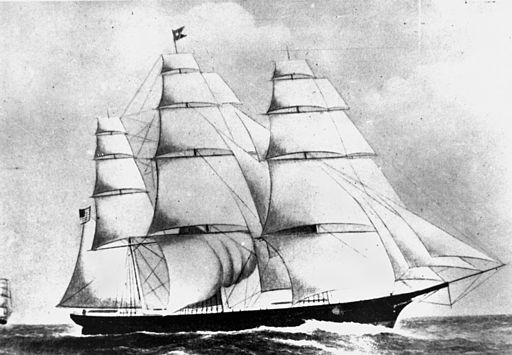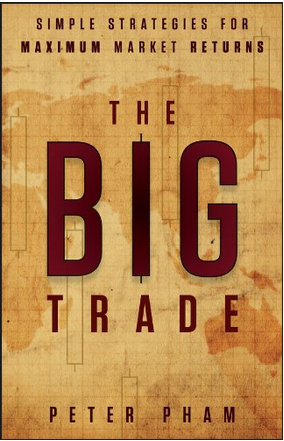
The Flying Cloud American Clipper (Source)
In 1852 the clipper ship The Flying Cloud sailed from New York to San Francisco in 89 days, a world record time that would stand until 1989. What is truly remarkable about the story of The Flying Cloud is not only the speed, but the motivation behind it. The clipper’s record setting voyage took place during the California Gold Rush, and the ship had to be fast to provide its passengers and crew a competitive advantage over others making their way out to San Francisco to strike it rich. In modern markets, we should all strive to be like The Flying Cloud, as the fastest ships in the sea are first to capture global economic booms.
This from Peter Pham, a Canadian expat hedge fund manager who moved to Asia in 2006.
Peter manages the Prestige Global Growth and Income fund with Phoenix Capital. He is the author of The Big Trade (Wiley 2013) and is a past and contributor to Bloomberg, Wall Street Journal and other publications. Peter’s website, AlphaVN.com, is an independent research and consulting firm focused on Southeast Asia, where he regularly shares his views on capital markets and trading.
Peter, thanks for being with us. What’s your view on global markets right now?
Despite all positives and growth stories currently coming out of Asia, actually being here you get a new respect for American companies and their ability to take up a large percentage of world GDP, and their strong presence in Asia. I believe American multinationals are having a large impact on what’s happening in Asian markets right now.
According to the United States Commerce Department's announcement in the end of 2013, US investments in Asia-Pacific saw a jump in 2013 to a total book value of US$695.29 billion, the second biggest dollar rise in overseas US investments after Europe. The largest increases were in Australia, Singapore and China. US investments in Singapore climbed over 10% from 2012 to last year. China received an increase of 15%, while Australia also obtained 11% of US inflow capital.
In terms of the rate of return (income divided by investment) for US investments, Asian countries achieved impressive rates in 2013. Singapore's rate of return beat the Asia-Pacific average by nearly five percent. In South East Asia, the highest yield of returns comes from Indonesia and Malaysia, where yield of returns are over 20%.
Being in Asia you get some insight into not only what is happening in Asian markets, but also the global implications. The strength of American multinationals gives hope and insight as to why the USA is so strong globally despite the bearish view on the underlying fiscal/financial situation in the USA.
US multinationals' outsized contributions to productivity growth matter greatly because productivity increases have delivered nearly three-quarters of US real GDP growth since 2000. A mind-boggling 45 percent of profits earned by companies in the Standard & Poor's 500 is derived from foreign operations these days. U.S. multinational companies have strong leadership positions abroad and don't have to worry about incurring added investment costs to establish markets there.
Recently, the International Monetary Fund cut its global economic growth forecasts for the third time in this year, warning of weaker growth in core euro zone countries, Japan and big emerging markets like Brazil. While richer countries like Britain and the United States are seeing stronger expansions, the IMF downgraded forecasts for the three biggest economies in the euro zone currency bloc - Germany, France and Italy - and said it was essential advanced economies maintain monetary stimulus.
Growth projections for Japan and Brazil were also lowered, among others. The IMF said potential growth in emerging markets is now 1.5 percentage points lower than what it foresaw in 2011.
The American economy, on the other hand, appears to be gaining speed. GDP expanded at an annual rate of 4.2% in the second quarter and non-farm payrolls increased by more than 200,000 positions for six consecutive months through August, marking one of the strongest periods of job creation on record, while unemployment fell to 5.9%. The growing evidence that the U.S. economy is picking up speed will feed the debate over when the Federal Reserve will increase its benchmark interest rate, something it hasn’t done since 2006.
What is your strategy for deploying capital in this market?
The world has become a risk-on risk-off market. If you can ascertain the probabilities of being risk-on consistently, you can build a diverse portfolio based on global trends.
In Asia, when risk is on you can go into frontier markets, but when risk is off you must be defensive and go back into developed markets. This is how you capture market opportunities. Once again this goes back to my earlier points about the importance of portfolio diversity and the flexibility it provides. I also like to reference The Flying Cloud in regards to deploying capital. The fastest ships capture economic booms, and as such we need to move quickly in this market.
For example, we started running our portfolio in the spring of this year. We bought more while risk was on, then when the market pulled back and risk went off we went into USD and our portfolio became less diverse. However it is important that we have the flexibility to make these kinds of moves.
Why should Canadian investors care about Asia?
Simply put – Asia is full of emerging, growing, frontier markets. Just as markets move in cycles, regions move in similar cycles. It is important to keep our eyes on these emerging markets as they flow between risk-on and risk-off cycles. When risk is on, we have a big appetite for frontier markets like those in Asia, however when risk is off we must be more cognizant of global trends.
Asian markets change rapidly, and can be a source of great success for all investors, Canadians included. This underlines the importance of global portfolio diversification. Asia-Pacific is the fastest growing region of the global economy, and its economic weight has increased in the last decade, reaching over 30% of world GDP in 2013. In particular, India’s GDP growth is estimated to hit 6.3% for 2015-2016, driven by optimism over potential reforms. Projections for China are similarly optimistic, with the Asian Development Bank (ADB) predicting GDP growth of 7.5% this year, and 7.4% in 2015.
Mongolia and Myanmar are two smaller economies in the region that have experienced impressive growth, averaging 6.12% and 8.99% respectively in recent years and are expected to do so once again in 2014 and into the medium term. The speed of growth is impressive, but much of their potential still remains uncovered.
What was the thesis of your book and how has it held up these past few years?
The thesis of my book is this; we must look at markets from an agnostic and pragmatic standpoint, the data is the data, and this doesn't change based on media stories. We must assess markets in their purest form, based on information and statistics. Common thinking is that markets are efficient, and it is hard to find opportunities to exploit the market. We use probabilities to determine ideal points to begin building a position.
People think central banks have changed the market, but from pure position building standpoint has not changed at all. The Big Trade relies on testable probabilities that remain constant over time – regardless of what happens in the market. The main flaw in traditional technical analysis and fundamental analysis is that as time changes their results change, but with The Big Trade, the results remain the same or even become more conclusive.
Case and point – we haven’t bought much in past few months, this has worked based on how markets have performed. This was not just dumb luck; we needed some insight to do this. We need to be opportunistic to capture movements in the market, and to do so we hold a lot of cash.
The book hinges around the idea of using opening range, which is a slice of price, as a tool to define probability that a stock would move beyond the opening range a certain magnitude. For example, 80% of trading time will surpass the previous day’s high or low. However, Monday and Friday are always different from other days. If the low price is on a Monday, there is a high probability that high price will fall on a Friday and vice versa.
What have you learned living in Vietnam?
Being here has given me a unique outlook and perspective on life in Vietnam.
As I’m sure you will agree, in Canada we can look at our American neighbors objectively, while all the while being cognizant of the elephant next door. In Vietnam this also holds true in regards to relations with China. I feel as though this has given me some unique and unexpected common ground with the Vietnamese people, and in fact I believe it provides me with a competitive advantage in doing business here.
What’s the one point our readers should take away from this interview:
Globally diverse portfolios tend to trump domestic portfolios in terms of returns and lack of risk. Canada is such a small market compared to global equities – just take a look at the MSCI World Index. Canadians and investors across the globe need to be aware of the merits of global diversification. Roughly 70% of all portfolios are based in their domestic markets, and thus experience a small piece of the global market. I really cannot overstate the importance of diversity within a portfolio.
For more information:
Peter Pham
Managing Director
Phoenix Capital
3rd Floor Harbour Centre,
Grand Cayman KY1-1102, Cayman Islands
Email: [email protected]
Website: www.phx-cap.com























